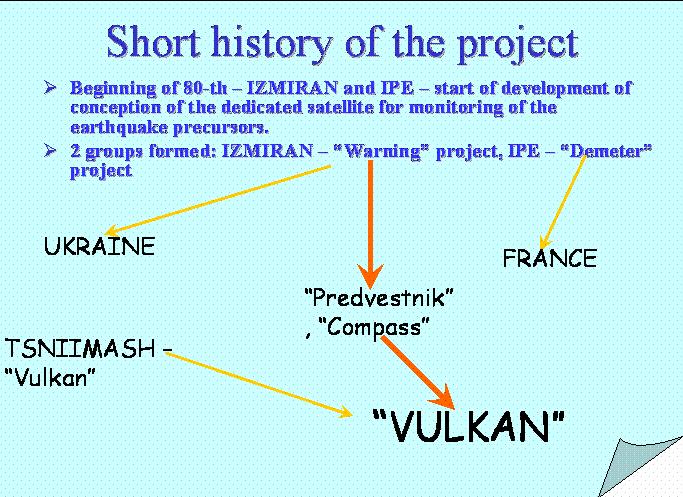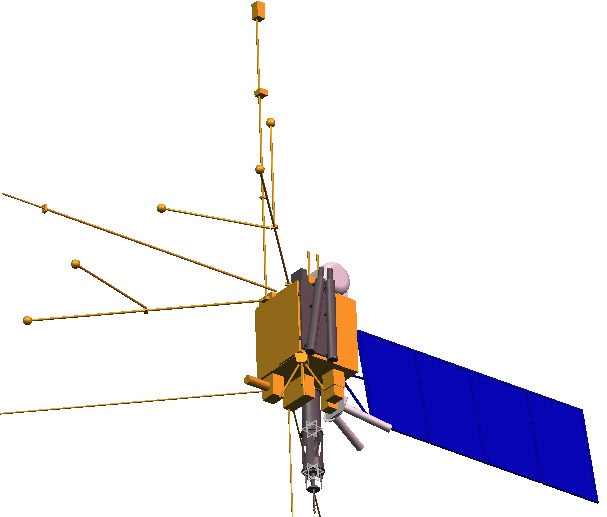数十年間のタイムスケールにおいて、地震被害分析手法の開発は本質的に進歩しました。しかしながら、数日から数年の時間スケールで特定の地震の予測は困難な問題です。衛星と地上設備は、地震の数時間から数日前に電離層の地震前兆現象を検出できるであろうと提案されてきました。
本仮説は現在、統計的研究によるロシア科学アカデミーによって編み出された物理的モデルと、背景となる電離層変動から分離可能な地震-電離圏前兆の主要な形態論の特徴についての理解によって支持されます。今や主要な問題は、定常的な全球データの欠如と、資金的にリスキーな研究と考えられることによる予算の制限です。
低コストの小型衛星はこれらの問題を解決します。2001年、ロシア航空宇宙庁(Rosaviakosmos)は、被害地震の前兆を含む自然災害モニタリングの衛星システムに対する提案を求めました。ロシア科学アカデミー・地磁気電離層電波伝播研究所(IZMIRAN)は、NIIEM(電気力学研究所、Istra、モスクワ)と共に、本契約を勝ち取りました。そして今、「Vulkan」と命名されたプロジェクトは、実装段階にあります。
しかし本プロジェクトの歴史は非常に長いものです。宇宙から測定され地震前兆と思われる現象に関する最初の結果は、既に1960年代に得られました(see Table 1)。
|
Alouette - 1964 Cosmos-274 -1969 OGO-6 - 1969 OVI-17 - 1969 ISIS-2 - 1971 АЕ-С -1973 GEOS-1 and 2 - 1978 Intercosmos-19 - 1979 Aureol-3 -1981 |
Intercosmos-Bulgaria 1300 - 1982 Salyut-7 - 1985 Meteor-3 - 1986 Cosmos 1809 -1987 Activny -(Intercosmos-24) -1989 TOPEX/Poseidon - 1996 MIR Space Station GPS -1994-2002 |
* 関連:High-energy charged particle flux variations in vicinity of Earth as earthquake precursors地震の接近に伴う電子の集中、電磁放射、イオン質量変動、粒子降下を含む地球近傍プラズマの異なったパラメーターが衛星によって記録されました:
Earthquakes with Reported Electomagnetic Precursors (CenSSIS)
"Alouette"、"АЕ―С"、"ISIS-2"、"Intercosmos-19 -24"、"TOPEX/Poseidon"、"GPS"衛星に搭載された局所的調査と電離圏サウンディング技術によって、強い地震の1~5日前に電離圏プラズマの特異な変動が検出された
"OGO-6"、"GEOS-1・-2"、"Cosmos-1809"、"Intercosmos-19, -24"、"Intercosmos-Bulgaria-1300"、"Aureol-3"のデータによって、地震動の数時間/数日前に、L-shellに沿いに数千km、子午線に沿いに約1000kmのサイズであるVLF/ELF放射の異常が観測された
"Intercosmos-Bulgaria-1300"、"Aureol-3"、"Meteor-3"、"Intercosmos-24"、軌道ステーション"Saluyt-7"および"Mir"のデータによって、エネルギー粒子フラックス(数百keV~数十MeV)と強い地震の間に、空間的・時間的相関が検出された
1980年代に開始されたVukanプロジェクトの短い歴史をFigure 1に示す。

Fig.1: The diagram of the "Valkan" project development history
熱中と悲観の間、多くの変遷の後に、地震前兆の研究・監視専用システムの最終的なコンセプトは固まりました。電磁気的互換性のない異なる観測手法を考慮し、2層で構成された衛星システムに分割することが決定されました。高度400kmの軌道の下層の衛星群は、電磁気ノイズ測定及び地表温度のようなリモートセンシングを行います。より高い軌道の衛星群は、主にトップサイド・サウンディングを含む宇宙プラズマの測定を行います。上層の軌道は1000km付近に選択されました。
「Vulkan」システムの下層衛星群は、異なる経度に等経度に配置された12機の衛星で構成されるでしょう。上層衛星システムは同じ原則で軌道配置された6機の衛星で構成されます。
Figure 2に示す全ての衛星は、NIIEMで開発された同じプラットフォームを基本に製作されるでしょう。全ての軌道は、傾斜角82度*の太陽同期準回帰軌道です。衛星のミッションライフは最低7年でしょう。基本プラットフォームの主要諸元をTable 2に示します。
* ロシアでは98度とは表記しないようである

Fig.2 The general view of the basic platform of "Vulkan" satellite system
Table 2
|
Mass of the payloads Satellite mass Average orbit power consumption of the support module Supply voltage Attitude control accuracy along orbital coordinate system (OCS) axes Attitude control stability per each axis Accuracy of the S/C orbit position determination Guarantee mission lifetime |
117 kg 202 kg 90 W 27 V 20 ang.min 0.005 °/sec +/-70 m 7 years |
最終ペイロードは未定ですが、測定される主要なプラズマ及び他のパラメーターは既に選定されています:
本計画は、DEMETER、VARIANT、COSMICのような地震前兆現象の観測を目的とする他の宇宙計画と緊密に協力した開発を図ります。準静的電場・磁場
電子・イオン密度及びその高度分布
イオン-質量構造
ELF-VLF及びHFの電磁放射
電子・イオン温度
電子・イオンフラックスのパワー・スペクトラム(15 keV以上)
複数帯域の赤外放射強度
波長727-1103nm帯の放射
